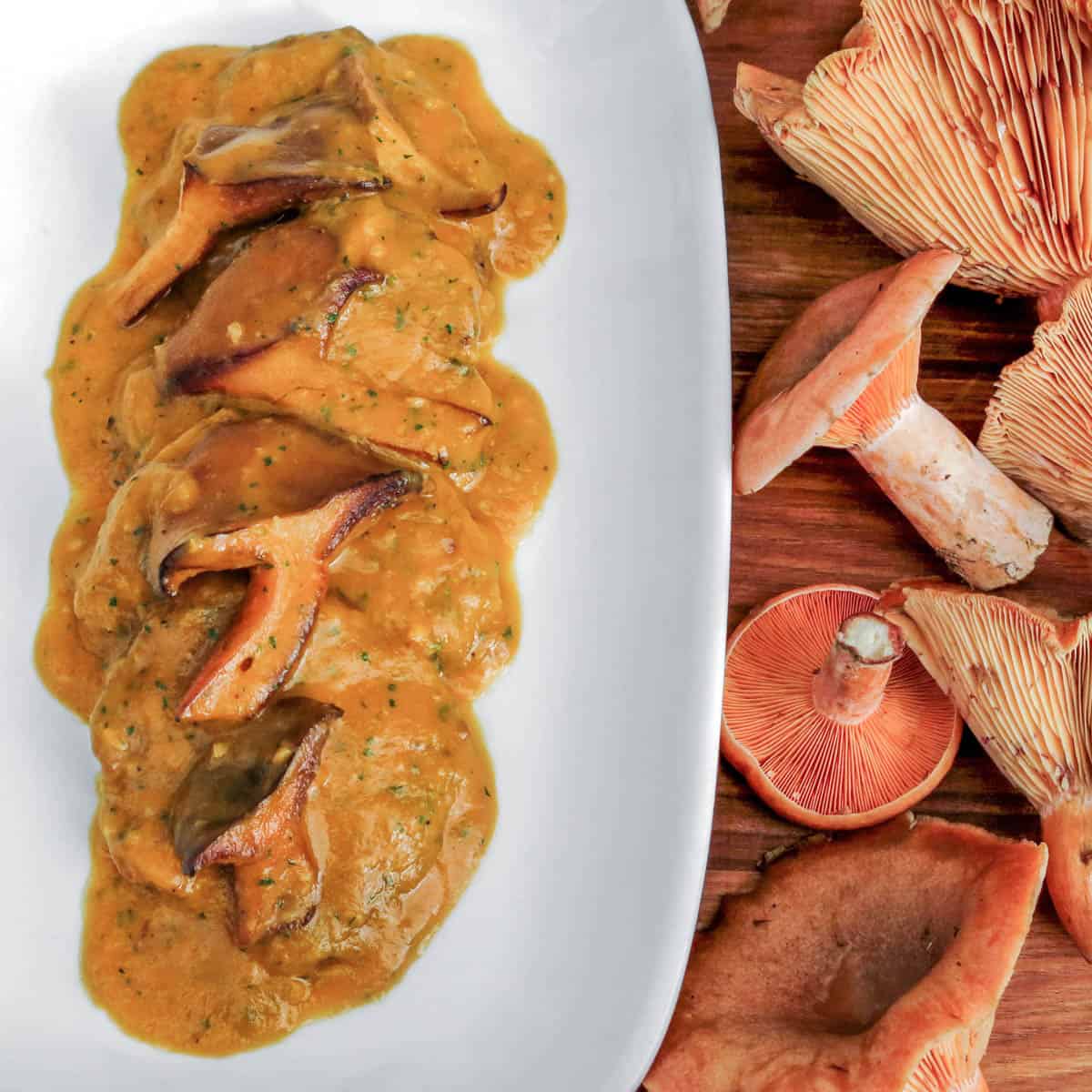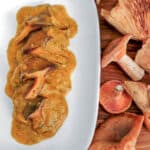A traditional Spanish recipe often using niscalos or rovellon mushrooms, this fricando is thin slices of beef or veal simmered in a light sauce of crushed almonds, vegetables and saffron milk caps. It's similar to Italian scallopini, and it's crazy good.

I learned about the dish online. Google "recitas con rovellons" and you'll get a bunch of You Tube videos from homey Spanish kitchens as well as personal blogs and plenty of Spanish recipe archive websites.
Essentially a variation of a French dish called fricandeu, it was originally a piece of veal loin studded with pork lard and braised. If veal is unavailable, small cutlets of chicken or pork can be used.
The modern version has become a saute of thinly sliced meat similar to scallopine quickly simmered with saffron milkcap mushrooms and a mix of chopped almonds, garlic, and tomato. As with many recipes, everyone has their favorite way to make one, some include carrots, some use chunks of meat.
Of all the variations of the dish I've seen, a fricando of thin veal cutlets simmered with saffron milkcaps seems to be the most popular. It's definitely my favorite.
The Picada
Traditionally a picada is used to finish a fricando. A picada is some parsley, garlic, and toasted nuts chopped together until very fine. The nuts will slightly thicken the dish, and add some nice texture. Some variations of fricando I saw don't use the picada, but I definitely recommend it.
Spanish Fricando with Mushrooms
Equipment
- 1 12 inch skillet
- 1 cutting board
Ingredients
- 12 oz beef or veal top round cut into thin cutlets, see note
- ½ cup white flour for dredging and browning the cutlets
- 1 qt saffron milk caps see note
- 1 cup chopped tomatoes peeled and seeded
- 1 cup diced sweet yellow onion
- ½ cup diced carrots
- 3.5 cups water
- Salt and pepper to taste
- Tasteless oil for cooking like grapeseed or canola
- Picada
- ¼ cup loosely packed Italian flat leaf parsley
- 1 clove of garlic about the size of a nickel
- ⅛ cup toasted marcona almonds
Instructions
- Begin by getting a wide saute pan (a 10" will do) hot and adding oil, season all the cutlets with salt and pepper on one side only (to prevent over seasoning). Dust each cutlet in flour, tapping off any excess, and then cook until nicely browned on both sides, about ten minutes.
- You may need to work in batches if you have a small pan, just remove the browned cutlets, add some additional oil to the pan, and repeat until all the cutlets are browned. When the cutlets are browned, add the vegetables to the pan the meat was cooked in and saute for a few minutes, making sure the bottom of the pan and the meat drippings do not burn.
- Add the water and scrape the bottom of the pan with a wooden spoon to remove the drippings. Put a lid on the pan so too much water doesn't evaporate and cook until the vegetables are very tender, about 10-15 minutes
- While the veggies cook, prepare the picada: chop the parsley, garlic, and toasted marcona almonds until very fine, set aside and reserve. When the vegetabes are soft, transfer them and their liquid to a blender and buzz on high until the mixture is smooth and creamy.
- Get a big saute pan and add some oil, heat until hot and then add the mushrooms. Cook the mushrooms for about 5 minutes until they have taken on some color and are golden brown, cooking on medium high heat. When the mushrooms are nicely caramelized, return the beef and the pureed sauce to the pan, cover with a lid cook this for another 20-30 minutes until the meat is very tender.
- When the sauce has thickened and the meat is tender, add the picada and cook for 2 minutes, then finally check your seasoning for salt and pepper if needed and serve. Some plain rice, (or saffron rice) would be great with this.


Ann Butler
We found these in abundance in SE Wisconsin this year (2019} near, but not under white pines in mid September. Tasty sautéed, but are they known for causing gastric upset at all?
Jorge Vilanova
Fricando is one of my favorite recipes. I prefer to use the recipe from the book Catalan cuisine by Colman Andrews. In this recipe the basis is not the picada but the Sofregite which is based on onions and tomatoes cooked in olive oil. I can send you this recipe if you wish.
What called my attention to your article above is the phrase "With a fridge full of saffron milkcaps". I have never been able to find fresh saffron milkcaps in the USA and I use canned ones when I can get them in Spain or dried ones.
Since I grew up in Spain, I am very familiar with these mushrooms and the best way to prepare them is grilled with a touch of olive oil and sat. Some people also sprinkle them with finely diced parsley and garlic.
If you could give me some information on obtaining fresh saffron milkcaps I would very much appreciate it.
Simcerely,
J. Vilanova
Alan Bergo
That's some great info, I'd love to take a look at the Fricando recipe you're talking about. As far as saffron milkcaps, yes, I do find them in quantity here in Minnesota where I live, but it's not every year, need a lot of rain during the fall for them to show up, and they are always with white pine in my patch, hope that helps, I see them with Norway pine too.
Jorge Vilanova
Hello Alan,
Looks like I will be going to Minnesota when the mushrooms show up!!
Just kidding for now but it may not be out of the question when the time comes.
As far as the recipe, I would like to send this to your personal email address to avoid any problems with copyright.
I assume you have my personal address.
Always happy to chat with a fellow mushroom lover.
As far as grilling the mushrooms see the attached link. Hope you enjoy it. I'm not in any way related to this website.
Jorge
https://catavino.net/rovellones-a-spanish-meal-in-a-mushroom/
Alan Bergo
Thanks Jorge, I took your # off of the comment, but have it saved. I'll shoot you an email. Thanks.
Marc Gracia
In Catlonia, the Lactarius Deliciosus is called "Pinatell" (Pine-sap), it's also very apreciated, but what we call Rovello is the Lactarius Sanguifluus.
I'm afraid it's only a European specie. But they are very similar, so don't worry too much. Lactarius Sanguifluus has a more potent flavour and the usual milk this speciaes expel when cut is of a redish color. (Hence the name, Sanguifluus -> Bloody)
Heather M Johnston
Come to the Oregon coast in mid October and you will find as many as you can carry. ☺️